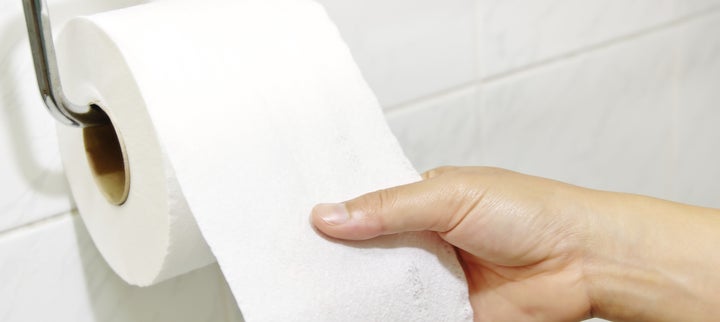
The good news first: You are not pooping wrong. Unless you're doing headstands on the latrine, there's no real way to mess that up.
The better news: With a few minor adjustments, you could make your elimination experience a whole lot faster and easier, with significantly less strain on your body. You might even see a few health benefits.
Here’s the story.
Potty’s Over
Odds are you’ve been using a Western toilet your whole life. And while this is a positive development for modern-day concepts like sanitation and disease prevention, it’s not the best way to actually defecate. "Our toilets put us in a 90-degree angle that is not as natural for evacuation of stool," says American Gastroenterological Association expert Laura E. Raffals, M.D. "[This] can contribute to bowel-related issues, particularly difficulty evacuating stool, which can lead to straining and hemorrhoids."
It’s especially not great for older people. "As we age, we are more prone to constipation and difficulty evacuating," says Dr. Raffals. "While these problems are a result of the normal aging process, our Western toilets do not help us out."
At the very least, our modern potties tend to lengthen our time spent in the bathroom. Great if you’re reading War and Peace. Not so great if you have to get somewhere.
Transition Your Position
For the best—and fastest—elimination, we should be squatting, like millennia of humanity before us, not to mention over a billion people on current-day Earth. "Our ancestors did not have toilets, but knew to squat when they needed to have a bowel movement," says Dr. Raffals. "The squat position is the natural position to eliminate stool."
This is due to simple anatomy. In a nutshell:
When you stand, your feces is held in place partly by the puborectalis muscle.
When you sit, the muscle relaxes a bit, allowing you to poop, though it can involve some uncomfortable straining.
When you squat, that muscle relaxes completely, making the whole process a comparative breeze. (Here’s a handy diagram.)
While it’s not the most-researched topic in the world, small studies have shown that squatting reduces strain, slashes time on the toilet, and improves feelings of bowel emptiness. (Always a plus.) Some experts have even suggested that the position can help relieve constipation, diverticulitis, and other gastrointestinal ailments prevalent in older adults.
Of course, to a generation plagued by bad knees, sore backs, and 30-or-so extra pounds, squatting in a restroom sounds like a bad idea. What if we fall? What if we get stuck? What if we … no, don’t even think about it.
Anyway, there’s a compromise: Sit down and bring your knees up.
"Studies have shown that assuming the position of Rodin’s statue The Thinker (feet tucked up, torso leaning in - see photo) widens the anorectal angle (ARA) and lengthens the puborectalis muscle," making for an easier voiding, says Patricia L. Raymond, M.D., a private practice gastroenterologist and member of the American College of Gastroenterology Public Relations Committee. And the easiest way to boost your knees is with perhaps the most aptly named medical device in history: the toilet stool.
Enter the Squatty Potty (Not Literally)
Toilet stools or steps retail for between $20 and $30 under a variety of clever names: easyGopro, Re-Lax Toilet Footrest, Step and Go, and of course, Squatty Potty. That last one is possibly the best-known bathroom accoutrement in the world, thanks to its hilarious video ad, its appearance on Shark Tank, and 3,300 Amazon reviews that tend to read like this:
How can something that leaves me so empty also fill me with so much joy? -Kabir S.
What used to be a 5 minute process [dropped] to 2. The only thing I miss is that reading time I used to get. –JM
Point is, toilet stools work.
"A foot stool to elevate the knees above the bottom does actually help," says Dr. Raymond. "In fact, the greater the hip flexion by a squat or pseudo-squat with a poop stool, the straighter the rectoanal canal, and the less force needed to defecate." For older adults, the advantage to toilet stools over, say, a stack of magazines is A) portability and B) ergonomics: "It is better to get one that hugs the commode, rather than save money by using a standard step stool, but risk tripping and falling on the dismount, perhaps breaking a hip or wrist."
Beyond the Stool
Of course, if you're not quite ready to commit to another piece of bathroom furniture, or you prefer more biologically based options for relief, here are a few strategies endorsed by our experts:
Cut back on excess fiber. "If it’s not helping, it’s just producing big, bulky, dry stools that are even harder to get out," cautions Dr. Raymond.
Go right after you eat. Says Dr. Raffals: "This timing takes advantage of the body’s gastrocolic reflex, which is the body’s attempt to make room for the meal just ingested."
Try "timed toileting." "We teach people to poop on command," suggests Dr. Raymond. "Eat a greasy breakfast with a strong cup of coffee, take a brisk 15 minute walk, and then sit on the commode. If nothing comes, consider inserting a glycerin suppository to stimulate movement. With training, it is reasonable to expect a morning BM."
"If nothing works, DO see a gastroenterologist," urges Dr. Raymond. A weak pelvic floor, prolapse, rectocele, or dyssynergia may be among the diagnosable culprits making it harder to unburden our bowels.
Ultimately, these lavatory strategies may or may not solve your health problems, but they could make your toilet time a whole lot more pleasant. And isn't that what we want in the end (pun intended)?
Read more from Grandparents.com:

